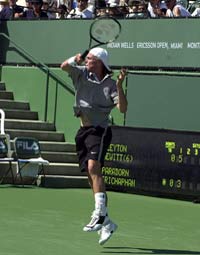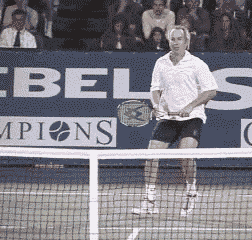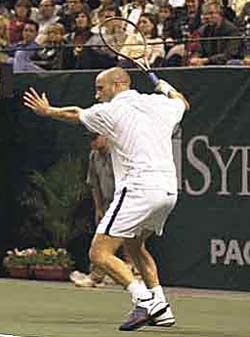|
TennisOne Lessons Playing Nature's Way: Instinct and Feelby Oscar Wegner Bjorn Borg used to say, “Tennis is a simple game.
Just hit the ball over the net one more time than your opponent.” That
is the essence. Yet for all its grace and simplicity, too often the game
and the mind are cluttered with a myriad of extraneous thoughts that only
confuse and restrict the flow. Most teaching pros try to instill a series
of ideas into the conscious mind i.e., take the racquet back early, bend
your knees, etc., these well meaning concepts only serve to make a simple
sport very difficult. To learn to play tennis well, I ask only that you
empty your mind and, using a simple, uncomplicated technique, focus on the
feel and sound of the ball on the racquet.
To clarify this concept, perhaps I need to get into
the philosophical aspect.
To best understand the causal relationship between
mind and body, ask yourself the question: who is the operator, the source
of the decisions of the action? The operator of the body-mind-thinking
process is the being, the center of awareness, the spirit, or the
consciousness center.
A simple test reveals who is in command. Close your
eyes and picture a cat, or a dog in your mind. Clearly see the picture you
created. Move it a bit from side to side. Now ask yourself the question,
who is looking? Who created the picture? Who is in control? The answer is
you, the soul, the actual source of your decisions and your existence.
So what is the mind? You just looked at it in the
previous test. It is the complete collection of mental image pictures,
including all perceptions, a record of all the experiences of life. It is
a tool the being uses to decide present and future actions, even
those that operate below the level of awareness.
How does this work in tennis? What would be the
most practical way to operate?
Tennis is a sport for the being, rather than the
mind. The being thrives on feeling, on aesthetics, on beautiful
coordinated moves; while the mind thrives on pictures, perfect poses,
right-wrong computations.
The best tennis pros are artists who operate at the
higher harmonics of aesthetics flows, with little thought involved, just
like concert pianists at their best and you too can learn to play this
way. This level of optimum performance is sometimes called the zone.
Instinct and FeelTo handle something well you need to put your
attention on it. You can place your attention on many things at once or
focus on just one thing at the time. What is most interesting about tennis
is that while you are focusing your attention on one thing almost
exclusively, everything else gets aligned with that instinctively.
Especially when you operate by feel!
Playing tennis on a conscious level which operates by
using several mental image pictures of consecutive body positions, is too
mechanical and slow and therefore inadequate.
Pro tennis players operate on an instinctual level,
avoiding as much as possible thinking about the task at hand. They
remember a stroke by what it feels like, not how it looks. They don’t
look into their mind to recall its mechanics. They play by feel, and
consciously slow their mind down. Breathing or walking are things you do
on an instinctive level – hence they are smooth and effortless. Unlike
say, balancing your checkbook, which requires great mental effort.
When playing tennis, it is the ideal to
operate on instinct and feel. Follow the ball attentively. Trust your instincts. It either feels good or it doesn’t. You be the judge.
Try different techniques, but beware of
falling into anything purely mechanical. Choose the one that gives you
more ease and a better and longer feel of the ball.
Judge your strokes by these simple criteria. Does it
feel natural? Does it get the ball in the court? Do I mildly resemble my
favorite pro? (Who has obviously mastered the stroke)
By copying your favorite pro you are actually using all the years of practice he or she needed to perfect his/her feel, or technique. If it doesn’t work well for you, emulate the stroke of another pro. You may learn in a few days by copying what it took the pro years to find. The simpler you make your task, the easier it will be
to know what to practice, what to put your attention on, and what not.
Again, you need to trust and develop feel. Do not strike the ball head on.
It won’t stay on your strings much and the feel is too short. Brushing
it up with topspin, for example, makes the ball stay on your strings much
longer. Starting and prolonging this contact on the strings below the
center of the racquet helps you feel the ball even more.
Focus on repeating that which feels best. Improve it, again by feel, practicing to get certainty and confidence. Practice until it works. Let Your Finish Occupy Your Mind
Tennis is a game of movement. First of all, find the
ball, then stroke it wherever you find it - all this by feel. Use your
mind to reinforce one thing, finishing your swing. Make a picture of the
position of your arm at the very end of the swing and repeat it over and
over. Leave the racquet at this position for a bit, looking at the landing
of your shot, even while turning and recovering. Relate this physical
finishing position of your racquet to your placement of the ball. This
particular process will give you a comfortable correlation between cause
and effect. The racquet up there, the ball landed there. Easy! Confidence
builds up!
It is the best way to occupy your mind. Follow the
ball into your racquet as long as possible and “finish” the stroke. It
will help calm your fears and keep you from freezing up or changing
something half way through the stroke. You may swing slow or fast, but
make sure your racquet goes all the way to the finishing position,
repeating it each the time. Observe Agassi, Kuerten, Sampras, the William
sisters, Hewitt, Capriati, Davenport. These pros “finish” every shot.
On the volley, which is a punch, this “picture”
of the finish would be the impact point, which acts as a stop. Prime
example of this would be John McEnroe, perhaps the best volleyer of all
time.
Practice your groundstrokes by simply finding the
ball, tracking it into your racquet, and feeling it on your strings,
propelling it over the net while finishing your stroke. No power yet.
Mainly feel. Drill. Repeat and repeat. The ball speed of your strokes will
slowly increase. You’ll know how to apply more and more power without
losing control.
To focus attention on anything else like feet
position for example, will only impair hand-eye coordination. It takes
something you learned by feel, instinctively, at a very young age, and
brings it to a conscious level. This floods thought patterns, impairs
observation, and actually serves to confuse. You begin to resemble a
marionette, working out which foot to put first, and where. And while you
are worrying about this, the ball may hit you on the head!
Another all too common error is taking your racquet
back too soon, a teaching method that fortunately is on the way out. This
also clouds the thought process, because it forces you to imagine and
adjust to the ball’s path ahead of time. Racquet back early, separates
it from the path of the ball and is a killer of timing, coordination, and
of ease of play.
Less is MoreIn tennis, as in many other sports, the less you
think about positions and of what is going to happen in the future, the
more you will focus on the present and the more feel you’ll have. Tennis
pros play in the present and so should you. Trying to judge the speed of
the ball only makes tennis more difficult. But here’s the secret, you
don’t need to judge it. Just look at the ball carefully; you’ll see
how much it slows down, first in the air, then a lot more after the
bounce. Research has shown that from baseline to baseline, the ball loses
close to 60 percent of its speed. And it always curves downward, less
speed, more curve! Just be ready to approach it from below!
Take your time, and become an observer, while you are
still running to the ball. Your legs may be moving fast to get to the ball
but your arm can wait a lot longer for the ball to get near your grasp.
Tennis professionals have favorite body positions
when executing their strokes, if they have available time. Those
preferences were acquired after much practice and determined by feel, not
by thought. Furthermore, professional players are usually on the run. In
this advent, they easily abandon their preferences and stalk the ball with
the racquet hitting it naturally wherever they catch up to it. When it
gets it within their grasp, they concentrate on getting it over the net,
moving the arm and hand independently of the rest of the body to
accomplish that aim. In other words, they play tennis with the hand, and
the rest of the body acts in an instinctive way.
How would we define this instinct? This takes us back
to where we started, in the beginning of this article.
Instinct is the operation of the being at the highest
level of thought, with perceptions coming in and decisions going out at a
speed too fast for the mind to grasp. Ironically, you can develop this by
waiting - by taking your time. Conversely, you can lose it by rushing.
In professional tennis, when the player is well
focused, the spirit, that inner core, is playing, computing by feel. The
ball may be traveling at a high velocity, but the player feels no need to
rush. He looks for the ball with the racquet as if it is a part of the
body, an extension of the hand. Finding it, he explodes with power,
guiding the ball over the net and in the intended direction. The total
focus is on finding the ball then looking to repeat a certain feel.
Attention to sound is equally import when focusing on
feel. It takes the mind off the task at hand. That is why top pros play
better when there is absolute silence during a point. They hear the
opponent’s stroke, the bounce, then their own stroke. This sound will
confirm to the player he is focusing and staying in the present time.
Take Your Time and Enjoy the Process
I have had students count to five after the bounce.
This seems to occupy and calm their minds, making for a far more polished
timing of the ball and a cleaner hit. After a while, the mind becomes
accustomed and the counting becomes unnecessary. However, if a player gets
nervous again, an indication of too much thought interference, he can
count again until he calms himself and gets back to the present time.
Even with the power of the modern game, top players
will tell you, “today I felt the ball,” or “I did not.” Those who
are not at the professional level can learn to hit the same way by
focusing on the same principles. Play as if the racquet was an extension
of the hand, stalk the ball, find it and feel it. Then strike it without
exerting too much force, without worrying about body position, or feet
placement. On the contrary, move naturally, in a light and subtle way,
like a cat on a hot tin roof. Balance yourself as you learned it as a kid,
chasing the ball in the most efficient way.
Using these principles I had total beginners hitting
60, 90, up to 120 ball rallies within an hour, at a medium pace, with full
forehand strokes. Miraculous, No! That is actually the potential of the
inner being when it acts naturally by feel apart from conscious thought.
For beginners, make your practice resemble a slow-motion movie, copying basic strokes from a favorite pro, stalking the ball, then exaggerating the finish. Play slowly, efficiently, without rushing, you’ll be more conscious of the angle of your racquet when meeting the ball, which is the determining factor of the direction of your shot. Later on, when the game speeds up, you’ll need only to adjust your speed, not your form. Tennis will become easier, more fun, because conscious thought about too many details will not inhibit the flow of your movement. So take your time and enjoy the process – it’s a beautiful game.
From 1982 through 1990 he promoted the same techniques to a large tennis academy for kids in Florianopolis, Brazil, helping coach Guga Kuerten until he was fourteen. From 1991 through 1995 he taught weekly on the New Tennis Magazine Show/ Tennis Television with Brad Holbrook, and, by Richard Williams own admission "made so much sense that he adopted them to coach Venus and Serena". From 1994 through 2000 Wegner worked for ESPN Latin America and for PSN, commenting on Wimbledon, the French and Australian Opens, ATP and WTA tournaments, and the Davis Cup. Oscar is currently in Los Angeles where he is developing his website academy, tennisteacher.com |
|||||||||||







 Oscar
Wegner began his quest to introduce his breakthrough teaching techniques
in the National Tennis School in Barcelona, Spain, in 1973. He encouraged
the coaches and players to follow the topspin style of Spanish great
Manuel Santana, two-time Grand Slam winner Rod Laver, Jack Kramer and Bill
Tilden among other former champions. Oscar's teachings included a natural
open stance on the forehand and swinging across the body, rather than
following the path of the ball.
Oscar
Wegner began his quest to introduce his breakthrough teaching techniques
in the National Tennis School in Barcelona, Spain, in 1973. He encouraged
the coaches and players to follow the topspin style of Spanish great
Manuel Santana, two-time Grand Slam winner Rod Laver, Jack Kramer and Bill
Tilden among other former champions. Oscar's teachings included a natural
open stance on the forehand and swinging across the body, rather than
following the path of the ball.